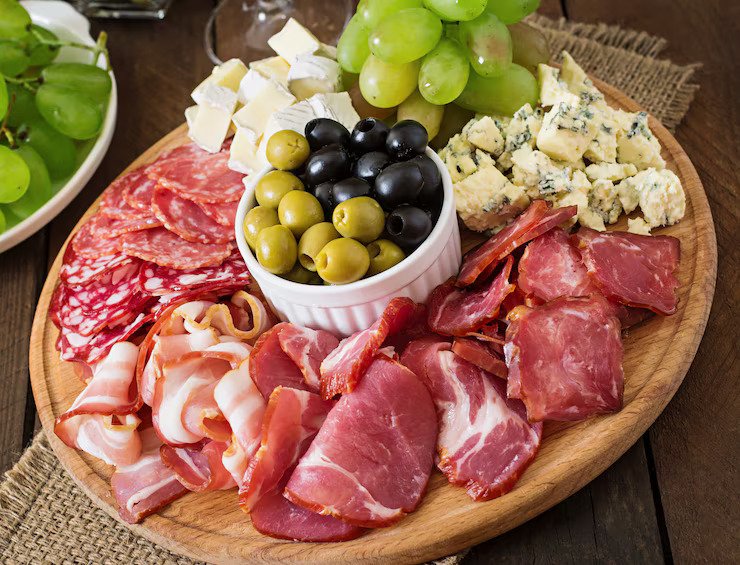In the heart of Western Europe, Luxembourg offers a culinary experience that reflects its diverse cultural tapestry. One of the country’s traditional appetizers, bouneschlupp, captivates with its simplicity and depth. This rich green bean and potato soup is more than just a prelude to a meal; it is a testament to the region’s agricultural roots and culinary heritage.
Bouneschlupp is a harmonious blend of locally sourced ingredients that showcases the essence of Luxembourg’s rural landscape. The soup is characterized by its velvety texture and the earthy flavors of green beans and potatoes, slowly simmered to perfection. Often enriched with the savory addition of bacon or sausage, each bowl tells a story of tradition and comfort. Bouneschlupp is typically served with a slice of rustic bread, perfect for soaking up the hearty broth.
While the recipe for bouneschlupp varies from one household to another, the core ingredients remain consistent. Green beans serve as the star of the dish, bringing a fresh and slightly sweet profile, while the potatoes add a creamy, comforting base. Whether enjoyed in a cozy home kitchen or at a local bistro, this appetizer embodies the essence of Luxembourgish hospitality and culinary tradition.
Traditional Appetizers in Luxembourg: A Culinary Journey
Luxembourg, a small but culturally rich country in the heart of Europe, offers a culinary scene that is as diverse as its history. Among its gastronomic offerings, traditional appetizers stand out for their unique blend of local ingredients and time-honored recipes. These dishes not only reflect Luxembourg’s heritage but also its connection with neighboring countries, creating a distinctive flavor profile that is both comforting and intriguing.
Kniddelen: The Quintessential Starter
One cannot discuss Luxembourg’s appetizers without highlighting the iconic kniddelen. Often referred to as Luxembourg’s version of dumplings, kniddelen are light potato-based dumplings that serve as a staple in many households. These dumplings are typically boiled to perfection and then pan-fried with crispy bacon, providing a lovely contrast of textures. The combination of the dumplings’ soft interior and the bacon’s savory crunch creates a satisfying balance that is further enhanced by the addition of apple compote. The sweet-tart apple compote acts as a counterpoint to the rich flavors, offering a refreshing bite that complements the dish’s overall richness.
Kachkeis: A Luxurious Cheese Indulgence
Another celebrated starter in Luxembourg is kachkeis, a creamy cheese spread that holds a special place in the nation’s culinary identity. Often enjoyed slathered generously on slices of fresh, crusty bread, kachkeis is made from a blend of melted cheese mixed with a touch of spices for added depth. The smooth and velvety texture of the cheese, coupled with its rich and slightly tangy taste, makes it a favorite among cheese enthusiasts. Traditionally served both warm and cold, kachkeis adapts beautifully to different dining settings, making it a versatile appetizer suitable for any occasion.
Other popular starters include kniddelen light potato dumplings served with bacon and apple compote and kachkeis a creamy cheese spread enjoyed on fresh bread. These dishes offer a taste of Luxembourg’s culinary tradition, inviting diners to explore a world where simple ingredients are transformed into extraordinary flavors. Each bite tells a story of a nation that cherishes its roots while embracing the nuances of its regional influences, making Luxembourg’s appetizers an essential part of its gastronomic landscape.
The Historical Roots of Luxembourg’s Starters
Luxembourg, a small yet culturally rich nation nestled between Belgium, France, and Germany, boasts a culinary tradition that is as diverse as its history. The country’s appetizers, often referred to as starters, offer a window into a past shaped by both local and neighboring influences. These dishes set the stage for a meal that reflects the harmonious blend of Luxembourg’s varied cultural tapestry.
A quintessential example of this culinary heritage is the ‘kniddelen,’ light potato dumplings that are traditionally served with crispy bacon and a tangy apple compote. This dish, often considered a staple in Luxembourg households, is a testament to the resourcefulness of the region’s cuisine, where simple, locally sourced ingredients are transformed into comforting and satisfying fare.
Another beloved starter is ‘kachkeis,’ a creamy cheese spread that is enjoyed on slices of fresh, crusty bread. This cheese, with its robust flavor and smooth texture, offers a taste of the dairy traditions that have been a part of Luxembourg’s agricultural landscape for centuries. The spread’s popularity is a nod to the country’s ability to preserve its culinary identity amidst the influences of its larger neighbors.
These starters, along with a variety of other traditional dishes, illustrate the historical layers of Luxembourg’s gastronomy. The influence of Germanic, French, and Belgian cuisines is evident, yet each dish retains a distinct Luxembourgish character, honed over generations. As the nation continues to evolve, its culinary traditions remain a cherished link to the past, providing a sense of continuity and community through shared meals and flavors.
Key Ingredients in Luxembourgish Appetizers
Luxembourg’s culinary landscape is a fascinating blend of influences from neighboring countries, yet it retains distinct flavors that are uniquely its own. A quintessential example of this is the classic Luxembourg appetizer, a bowl of Bouneschlupp. This rich green bean and potato soup is a staple in Luxembourgish cuisine, often served with a slice of hearty bread. To truly appreciate the nuances of this dish, one must understand the core ingredients that form its foundation.
The primary ingredient in Bouneschlupp is the green bean. Fresh, crisp, and vibrant, these beans provide the soup with its characteristic flavor and texture. They are typically harvested during the summer months, ensuring maximum freshness and flavor. Alongside green beans, potatoes play a crucial role. They add a creamy, comforting element to the soup, balancing the texture and providing a satisfying heartiness that complements the lighter beans.
Pork is another key component often incorporated into Bouneschlupp, usually in the form of smoked bacon or ham. This addition introduces a smoky depth and a savory richness that elevates the dish from simple to sumptuous. The pork is typically cooked slowly to release its flavors fully, harmonizing with the vegetables in perfect unison.
To round out the flavors, onions are sauteed until golden and fragrant, adding sweetness and a touch of caramelization. Garlic, though used sparingly, provides an aromatic undertone that enhances the overall profile. These elements combined create a soup that is both comforting and complex, making it a beloved choice for a starter.
Seasoning is integral to Bouneschlupp, with salt and pepper being the traditional choices. However, some variations might include a dash of nutmeg or bay leaves to introduce subtle layers of spice. Finally, fresh parsley is often sprinkled on top just before serving, offering a burst of color and a hint of herbal brightness.
- Green Beans: Fresh and crisp, providing the base flavor.
- Potatoes: Add creaminess and body to the soup.
- Pork: Usually smoked bacon or ham for a savory depth.
- Onions & Garlic: For sweetness and aroma.
- Seasonings: Salt, pepper, nutmeg, and bay leaves.
- Fresh Parsley: A finishing touch of color and flavor.
These ingredients, when combined with care and attention, result in a soup that is both nourishing and deeply satisfying. Bouneschlupp stands as a testament to Luxembourg’s ability to craft dishes that are simple yet profoundly flavorful, making it a perfect appetizer to introduce anyone to the region’s culinary delights.
Popular Dishes to Begin Your Luxembourgish Meal
Exploring the culinary offerings of Luxembourg opens a window into a world where rich flavors and comforting traditions take center stage. Among the various starters that set the tone for a Luxembourgish meal, a classic Luxembourg appetizer is a bowl of bouneschlupp. This hearty green bean and potato soup is often served with a slice of fresh bread, providing a warming introduction to the meal. Bouneschlupp is more than just a soup; it’s a reflection of Luxembourg’s agrarian roots, where locally-sourced ingredients come together to create a dish that’s both simple and deeply satisfying.
While bouneschlupp takes the spotlight, there are other noteworthy appetizers that deserve attention. Friture de la Moselle, a dish featuring small fried fish, is a nod to the country’s riverine bounty. These crispy delights are typically enjoyed with a squeeze of lemon and a side of tartar sauce, offering a crispy texture that contrasts beautifully with the tender fish inside.
For those with a penchant for charcuterie, Judd mat Gaardebounen provides a robust start. This dish combines smoked pork collar with broad beans, cooked to perfection, and seasoned with aromatic herbs. It’s a dish that brings together smoky, savory, and fresh flavors, making it a beloved choice for those who appreciate the depth of Luxembourg’s culinary traditions.
Incorporating these appetizers into your meal not only enriches the dining experience but also offers a glimpse into the cultural tapestry of Luxembourg. Whether you opt for the comforting embrace of bouneschlupp, the crispy allure of friture de la Moselle, or the hearty flavors of Judd mat Gaardebounen, each dish is a testament to the country’s rich culinary heritage. As you savor these traditional starters, you’ll find that they set a welcoming tone for the dishes that follow, inviting you to enjoy the full spectrum of Luxembourgish cuisine.
Where to Experience Authentic Luxembourgish Starters
Luxembourg, a small yet culturally rich country, offers a culinary landscape that is as diverse as its history. For those keen on diving into traditional Luxembourgish starters, the capital city is a good place to begin. One of the most iconic dishes to try is ‘Gromperekichelcher,’ crispy potato fritters seasoned with spices. These are often served at local fairs and Christmas markets, making them a nostalgic choice for many Luxembourgers. However, to experience this dish in its most authentic form, head to ‘Am Tiirmschen,’ a restaurant renowned for preserving regional recipes.
Another essential stop is ‘Le Bouquet Garni,’ where the elegant setting enhances the experience of savoring ‘Kniddelen.’ These light potato dumplings are typically paired with bacon and apple compote, offering a delightful balance of savory and sweet flavors. The restaurant’s interpretation of this dish is considered one of the best in the city. Meanwhile, ‘Brasserie Guillaume’ is celebrated for its ‘Kachkeis,’ a creamy cheese spread that is perfect when enjoyed on fresh bread. This establishment is a popular choice among locals and visitors alike for its dedication to high-quality ingredients.
Exploring Beyond the Capital
While the capital offers a plethora of dining options, venturing into the countryside provides a different perspective on Luxembourgish appetizers. In the small town of Echternach, ‘Heringer Millen’ presents a rustic ambiance, perfect for experiencing traditional starters in a more relaxed setting. Their menu often features seasonal variations of local favorites, including the aforementioned ‘Kniddelen’ and ‘Kachkeis,’ always prepared with a focus on authenticity.
For those willing to explore further, the village of Clervaux offers ‘Hotel des Nations,’ where the chef takes pride in showcasing regional dishes with a modern twist. Here, the emphasis is on using locally sourced produce, ensuring that every dish is a true reflection of Luxembourg’s culinary heritage. The starters, in particular, highlight the chef’s commitment to blending tradition with innovation.










